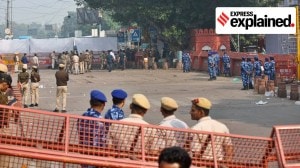Cyclone Dana nears Odisha, West Bengal coasts: What is the landfall of a cyclone?
Odisha has already evacuated over a million people from areas likely to be affected by cyclone Dana. What exactly does a landfall mean and how long does its impact usually last? We explain.
 Officials of the River Traffic Police and Disaster Management Group (DMG) make announcements on the banks of the Hooghly river ahead of ahead of Cyclone 'Dana' landfall, in Kolkata, Wednesday, Oct. 23, 2024. (PTI Photo)
Officials of the River Traffic Police and Disaster Management Group (DMG) make announcements on the banks of the Hooghly river ahead of ahead of Cyclone 'Dana' landfall, in Kolkata, Wednesday, Oct. 23, 2024. (PTI Photo) Heavy rainfall lashed parts of West Bengal and Odisha today (October 24) as the states braced for the impact of cyclone Dana later in the night. After having intensified into a severe cyclonic storm, with wind speeds between 88 to 117 km, cyclone Dana is set to make landfall.
According to the Indian Meteorological Department (IMD), the storm is very likely to move north-northwestwards and cross north Odisha and West Bengal coasts between Puri and Sagar Island. It will make landfall close to Bhitarkanika and Dhamara (Odisha), between the midnight of October 24 and the morning of October 25.
Odisha has already evacuated over a million people from areas likely to be affected. What exactly does a landfall mean and how long does its impact usually last? We explain.
What is the “landfall” of a cyclone?
Simply put, landfall is the event of a tropical cyclone coming onto land after being over water. As per the IMD, a tropical cyclone is said to have made a landfall when the centre of the storm – or its eye – moves over the coast.
Crucially a landfall should not be confused with a ‘direct hit’, which refers to a situation where the core of high winds (or eyewall) comes ashore but the centre of the storm may stay remain offshore. As per the US’s National Oceanic and Atmospheric Administration (NOAA), because the strongest winds in a tropical cyclone are not located precisely at the centre, it is possible for a cyclone’s strongest winds to be experienced over land even if landfall does not occur.
What is the damage caused by a cyclone’s landfall?
The damage caused by the landfall will depend on the severity of the cyclone – marked by the speed of its winds. For cyclone Dana, the impact may include extensive damage to kutcha houses, partial disruption of power and communication lines, minor disruption of rail and road traffic, potential threat from flying debris and flooding of escape routes.
The factors behind this kind of damage include extremely strong winds, heavy rainfall and storm surges which cause devastating floods in the coast.
How long does a cyclone landfall last?
Landfalls can last for a few hours, with their exact duration depending on the speed of the winds and the size of the storm system. According to the government, the wind speed of cyclone Dana during the five to six hours of the landfall process will be about 125 km per hour, with widespread impact in the region.
Cyclones lose their intensity once they move over land because of sharp reduction of moisture supply and increase in surface friction. This means that while landfalls are often the most devastating moments of cyclones, they also mark the beginning of its end.
This is an updated version of an explainer first published in 2023.






- 01
- 02
- 03
- 04
- 05































